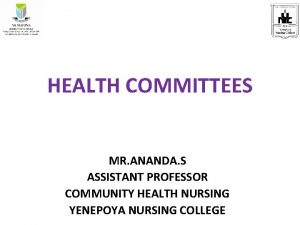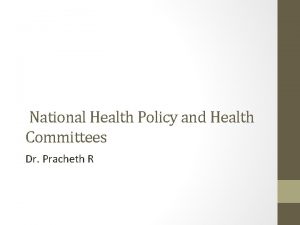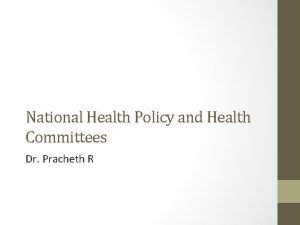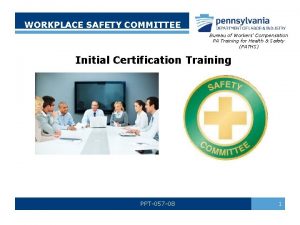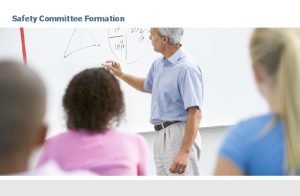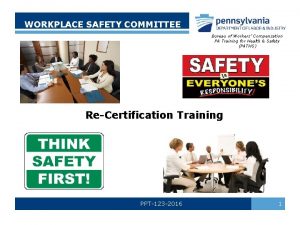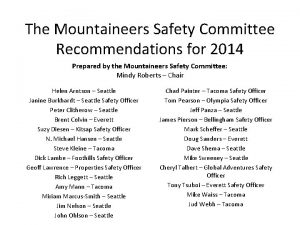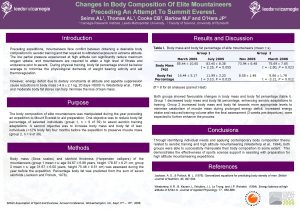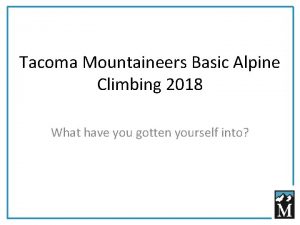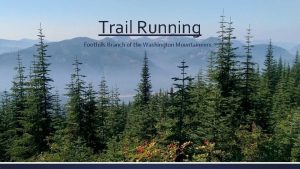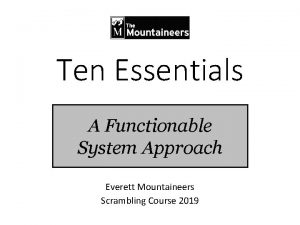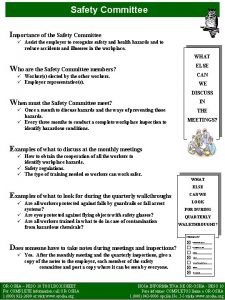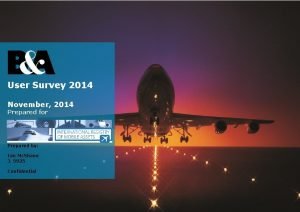The Mountaineers Safety Committee Recommendations for 2014 Prepared













- Slides: 13

The Mountaineers Safety Committee Recommendations for 2014 Prepared by the Mountaineers Safety Committee: Mindy Roberts – Chair Helen Arntson – Seattle Janine Burkhardt – Seattle Safety Officer Peter Clitherow – Seattle Brent Colvin – Everett Suzy Diesen – Kitsap Safety Officer N. Michael Hansen – Seattle Steve Kleine – Tacoma Dick Lambe – Foothills Safety Officer Geoff Lawrence – Properties Safety Officer Rich Leggett – Seattle Amy Mann – Tacoma Miriam Marcus-Smith – Seattle Jim Nelson – Seattle John Ohlson – Seattle Chad Painter – Tacoma Safety Officer Tom Pearson – Olympia Safety Officer Jeff Panza – Seattle James Pierson – Bellingham Safety Officer Mark Scheffer – Seattle Doug Sanders – Everett Dave Shema – Seattle Mike Sweeney – Seattle Cheryl Talbert – Global Adventures Safety Officer Tony Tsuboi – Everett Safety Officer Mike Waiss – Tacoma Jud Webb – Tacoma

Content and organization • Mission of The Mountaineers Safety Committee • Recommendations – Before, during, and after trips – Leaders *and* participants • For more information – additional resources

The purpose of the Safety Committee is to promote a culture of safety among The Mountaineers. • Collect and report incidents and near misses – Thank you for sharing experiences! • Educate and train or leaders – How can we avoid incidents in the future? • We volunteer our time because safety is fundamental to what we do

Thanks to leaders and participants for reporting incidents! • Kudos for taking the time to record your observations – they are valuable • All Mountaineers learn through reading incident reports • Make sure we get reports of all Major and Significant incidents, please! – Also report minor incidents and near misses • Kudos for how leaders and participants responded to incidents – our training works.

1. Skills and training • Ice axe arrest skills still show up most frequently in field trip incidents. Committees, instructors, and participants should recognize this and assess how to avoid incidents. • Slips on snow show up most frequently overall. Committees should ensure snow travel instruction not just covers proper use of crampons and ice axe, but provides equal treatment in teaching courses – with crampons on and with ice axes. We know of only one slip on snow when crampons were worn.

2 A. Preparation for trips – leaders • If a participant brings you a concern, pay attention. Consider carefully. Respond. – Speaking up takes courage – respect that – Consider Colin Powell’s reflection (next slide) • Create a culture that invites participation in decisions involving the whole group • Clearly identify process and timing for emergency trip contact (and make sure you identify one for each trip you lead)

“The day soldiers stop bringing you their problems is the day you have stopped leading them. They have either lost confidence that you can help them or concluded that you do not care. Either case is a failure of leadership. ” --Colin Powell Source: NOLS

2 B. Preparation for trips – participants • No trips or events are easy the way most people would define that. Don’t be lulled into thinking lower-grade activities are easy. • Participants really need to do a thorough selfassessment of their own health issues. Personal illness and conditioning shows up frequently in incident reports. • Don’t let ambition overcome safety

3. During trips • Watch for compounding issues that elevate risk – recognize these and discuss as a group. – “The group separated into two …” shows up often • Beware peer pressure to go anyway when conditions change or the goal changes. • Coming back another day is *always* an option. There will be other opportunities. • Anyone can say “stop” – the mantra of Mountain Rescue. The leader, but also each participant, should have veto authority.

4. When incidents happen • Pause and consider your alternatives • If assistance is required – On land call 911 first (when you can). If no cell service exists, consider a Personal Locator Beacon or Satellite Messenger (if available) – On water call the US Coast Guard on channel 16 of your VHF radio (preferred) or call them at 206 -217 -6001 (backup plan) • When treating injured participants, err on the side of caution. • Splitting groups increases risk.

5. After trips • Call (206) 521 -6030 right away for any major incidents – 911, emergency medicine, Search and Rescue • Complete the online incident reporting as soon as possible • Leaders please report anything that qualifies as a Major, Significant, or Minor incident or near miss. • Very important – we need everyone’s feedback. Participants, please complete trip surveys.

For more information • www. mountaineers. org – About Us – Safety • www. mountaineers. org/safety/default. cfm – Annual safety reports (5 years) – Annual safety recommendations – Safety Highlights (5 to 10 per year) • safety@mountaineers. org

We are all responsible for safety The Mountaineers Safety Committee
 Strain formula
Strain formula Mudaliar committee 1959
Mudaliar committee 1959 Chadah committee
Chadah committee Yashpal committee report
Yashpal committee report Gvk rao committee recommendations
Gvk rao committee recommendations Dr a l mudaliar
Dr a l mudaliar Irani committee report
Irani committee report Jangalwala committee
Jangalwala committee Pa safety committee certification
Pa safety committee certification Explain the causes of french revolution
Explain the causes of french revolution Safety committee formation
Safety committee formation Committee of public safety
Committee of public safety Unsafe
Unsafe Egg för emanuel
Egg för emanuel

